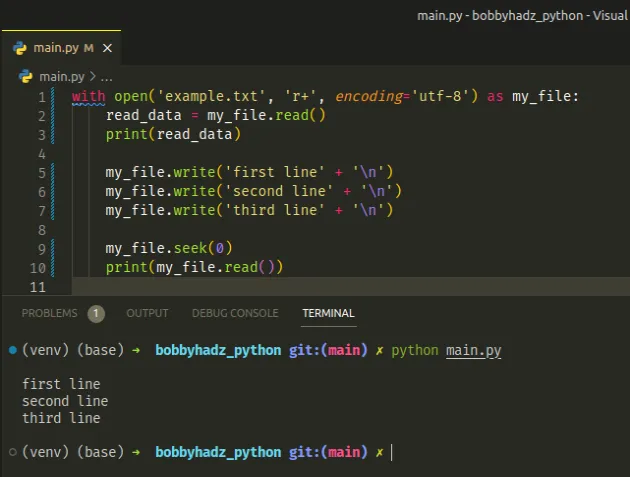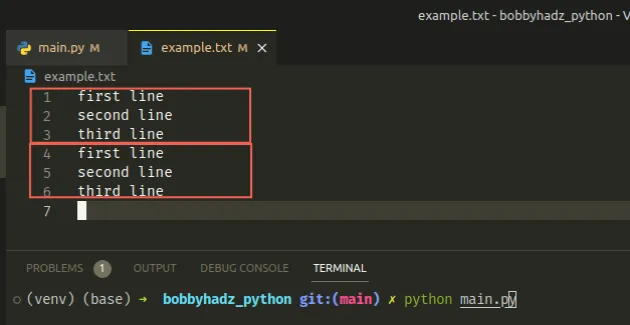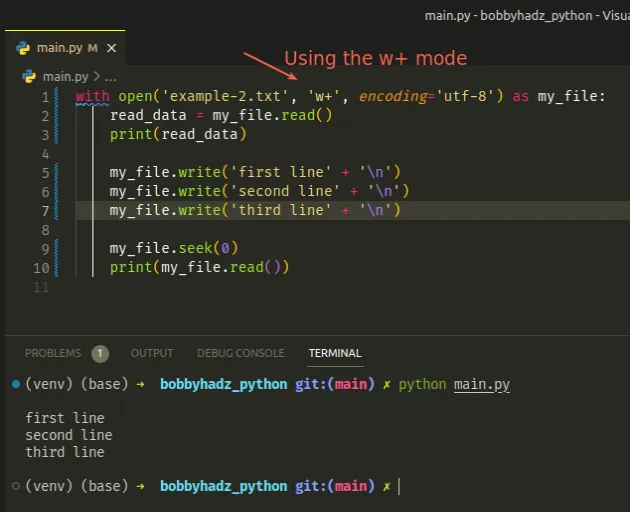ValueError: Must have exactly one of create/read/write/append mode
Last updated: Apr 8, 2024
Reading time·3 min

# ValueError: Must have exactly one of create/read/write/append mode
The Python "ValueError: must have exactly one of create/read/write/append mode" occurs when we specify an incorrect mode when opening a file.
To solve the error, use the r+ mode if you need to open the file for both
reading and writing.

Here is an example of how the error occurs.
# 👇️ Using incorrect 'rw' mode # ⛔️ ValueError: must have exactly one of create/read/write/append mode with open('example.txt', 'rw', encoding='utf-8') as my_file: read_data = my_file.read() print(read_data) my_file.write('first line' + '\n') my_file.write('second line' + '\n') my_file.write('third line' + '\n') my_file.seek(0) print(my_file.read())
We used an unsupported rw mode which caused the error.
# Opening a file for both reading and writing
If you need to open a file for both reading and writing, use the r+ mode
instead.
# ✅ Using r+ mode with open('example.txt', 'r+', encoding='utf-8') as my_file: read_data = my_file.read() print(read_data) my_file.write('first line' + '\n') my_file.write('second line' + '\n') my_file.write('third line' + '\n') my_file.seek(0) print(my_file.read())

The r+ mode opens the file for reading and writing and positions the stream at
the beginning of the file.
If you run the code sample multiple times, you will write the lines multiple times to the file.

This is because when a file is opened using the r+ mode, its contents are not
truncated.
If you want to truncate the file every time you open it, use the w+ mode
instead.
# Using the w+ mode instead of r+
You might also see the w+ mode being used. It opens the file for reading and
writing and creates the file if it doesn't already exist.
If the file exists, it is truncated. Truncating the file means that all contents of the file are erased.
with open('example-2.txt', 'w+', encoding='utf-8') as my_file: read_data = my_file.read() print(read_data) my_file.write('first line' + '\n') my_file.write('second line' + '\n') my_file.write('third line' + '\n') my_file.seek(0) print(my_file.read())

On the other hand, the r+ mode doesn't create the file if it doesn't exist,
nor does it truncate the file.
r+ and w+ modes position the stream at the beginning of the file.# Using the a+ mode to open the file for reading and writing
There is also an a+ mode which opens the file for reading and writing.
The a+ mode creates the file if it doesn't already exist, but it positions the
stream at the end of the file.
with open('example-3.txt', 'a+', encoding='utf-8') as my_file: read_data = my_file.read() print(read_data) my_file.write('first line' + '\n') my_file.write('second line' + '\n') my_file.write('third line' + '\n') my_file.seek(0) print(my_file.read())
The difference between the a+ mode and the other 2 is that the stream is
positioned at the end of the file.
The file.seek(0) method can be used to position the stream at the beginning of
the file.
The a+ mode also doesn't truncate the file if it already exists.
You can view all of the other possible modes to open a file in this table of the official docs.
Here are the most commonly used modes:
| Name | Description |
|---|---|
| 'r' | open for reading |
| 'w' | open for writing (truncates the file first) |
| 'a' | open for writing, appending to the end of the file if it exists |
# Additional Resources
You can learn more about the related topics by checking out the following tutorials:
- How to Read a file character by character in Python
- Read a file until a specific Character in Python
- Remove the Extension from a Filename in Python
- How to save user input to a File in Python
- How to check if a File is Empty in Python
- Count number of unique Words in a String or File in Python
- Create a file name using Variables in Python
- How to get the File path of a Class in Python
- Taking a file path from user input in Python
- ValueError: I/O operation on closed file in Python [Solved]
- io.UnsupportedOperation: not readable/writable Python Error

